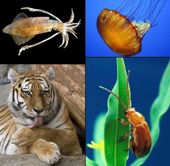Classification
Domain-- Eukarya
Kingdom-- Animalia
Phylum-- Mollusca
Class-- Gastropoda
Order-- Stylommatophora
Family-- Pupillidae
Genus-- Gastrocopta
Species-- Gastrocopta tappaniana (C.B. Adams, 1842)
Common name: White Snaggletooth
Classification information gathered from (Encyclopedia of Life)
The meaning of the Latin scientific name as well as the origin of the common name are both unknown. "Gastro" means stomach or to cut but the meanings of "copta" and "tappaniana" are unknown.
Organisms of the Domain Eukarya have a few common characteristics. This domain contains all organisms with eukaryotic cells (those that have membranous organelles) and are either unicellular, colonial, or multicellular (Classic. sidwell.edu).
In the Kingdom Animalia, organisms are classified by being multicellular, eukaryotic heterotrophs. These organisms develop from embryos, lack rigid cell walls, and are usually motile (Anderson, 2010).
Phylum Mollusca, in Latin, translates to "soft of body." Organisms in this phylum have a complete digestive tract, are bilaterally symmetrical, triploblastic, and are eucoelomates having a true coelem lined with peritoneum (Hickman, 2009).
Class Gastropoda is the largest class within the Mollusca phylum, containing
about 70,000 living species as well as over 15,000 extinct species
(Hickman,
2009).
Organisms in the Gastropoda class are characterized by having a single, spirally
coiled shell, as well as a mantle cavity and mantle, and a muscular foot that is
broad and flattened.
These organisms also have a 180° twist in the visceral
mass, commonly known as torsion. In addition, gastropods have an
operculum, which is a hard plate that closes off the shell for protection
(Hickman, 2009).
Organisms of the Order Stylommatophora are characterized by a long pedal gland placed beneath a membrane and retractile tentacles (BayScience Foundation, 2009).
Family Pupillidae snails are minute, usually with pupa-shaped shells. The shell aperture usually contains several to many teeth. These snails are found world-wide (Burch, 1962).
Snails in the Genus Gastrocopta are characterized by having parietal and angular lamellae converging inward, and are more or less united (Burch, 1962).
The species Gastrocopta tappaniana has characteristics that fall into all of the above categories. For further description, please see the Physical Description page.
Back to Home Continue to Physical Description
